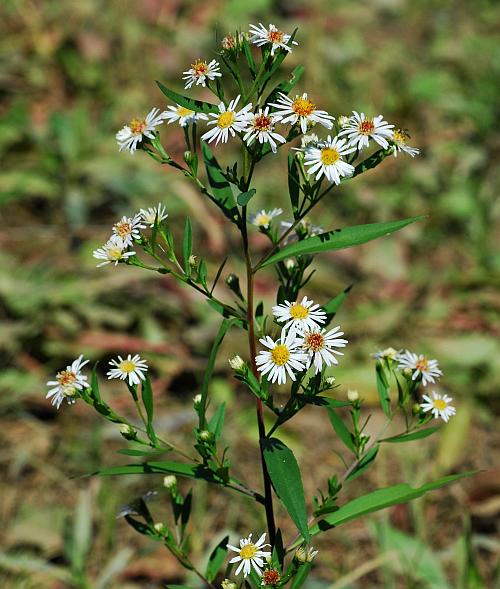Symphyotrichum lanceolatum (Willd.) G.L. Nesom
Tall White Aster

Native
CC = 3
CW = -3
MOC = 75
© SRTurner
Symphyotrichum lanceolatum (Willd.) G.L. NesomTall White Aster | |
 |
Native CC = 3 CW = -3 MOC = 75 |
© SRTurner |
|
Family - Asteraceae/Astereae Habit - Perennial rhizomatous forb, somewhat colonial.
Stem - To 1.5 m, usually solitary, usually branched above the midpoint, sparsely to moderately pubescent above, the hairs usually in longitudinal lines, usually glabrous toward the base.
Leaves - Lowermost leaves usually wilted at flowering, sessile or with a short, poorly differentiated petiole, the blade 1-8 cm long, 0.5-2.0 cm wide, oblanceolate, tapered at the base, angled to a pointed tip, the margins with spreading or antrorse hairs and usually toothed or scalloped, the surfaces glabrous. Upper stem leaves often somewhat reduced, sessile, sometimes slightly expanded but not clasping the stem, the blades 1-14 cm long, linear to broadly oblanceolate, the margins entire or sparsely toothed, otherwise similar to the lower stem leaves.
Inflorescence - Terminal panicles, usually leafy (variety dependent), the heads appearing mostly short stalked and usually oriented in various directions, the bracts along the ultimate branches 0.2-1.0 cm long, more or less leaflike, linear or narrowly oblong-lanceolate, somewhat shorter than the adjacent foliage leaves.
Heads - Mostly 1.0-2.5 cm in diameter (including the extended ray corollas) at flowering.
Involucre - Involucre 3-7 mm long, cup-shaped to slightly bell-shaped, the bracts in 3-5 unequal, overlapping series. Involucral bracts linear-lanceolate to narrowly oblong-oblanceolate, angled or tapered at the usually sharply pointed tip, lacking a bristlelike point at the ascending tip, the outer surface glabrous or sparsely hairy, the margins often slightly irregular and sparsely hairy.
Florets - Ray florets 20-45 in usually 1 or 2 series, the corollas well developed, 5-12 mm long, white or nearly so. Disc florets 15-40, the corollas 3-6 mm long, the slender portion of the tube noticeably shorter than the slightly expanded apical portion, the lobes 0.7-1.2 mm long, 30-45 percent of the total length of the expanded portion. Pappus bristles 3-6 mm long, white or off-white.
Flowering - August - October. Habitat - River floodplains, mesic or bottomland forests, margins of ponds and sloughs, ditches, roadsides, open disturbed areas. Origin - Native to the U.S. Lookalikes - Other small white asters, especially S. lateriflorum and S. ontarionis. Other info. - This attractive white aster occurs across Missouri as well as most of North America. It is particularly prevalent in or near floodplain regions of the large rivers. It is tolerant of disturbance and can often be found in wet cropland swales and along trail margins. Photographs taken near Dutzow, Franklin County, MO, 10-17-2019 (SRTurner). |